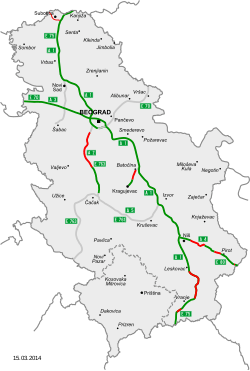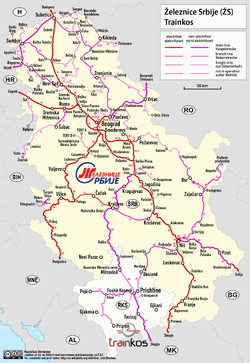Transport in Serbia
Transport in Serbia includes transport by road, rail, water and air. Road transport incorporates a comprehensive network of major (i.e. state) and minor (i.e. municipal) roads. Rail transport is fairly developed, although dual track and electrification are not very common. Water transport revolves around river transport while air transport around country's two main international airports.
Road transport

Serbian road network carries the bulk of traffic in the country: some 56.4 million passengers (carried by buses) and 9.9 million tons (carried by trucks) in 2016.[1] The road network are of comparatively lower quality to the Western European standards because of lack of financial resources for their maintenance in the last 20 years.
As of 2017, total length of roads is 45,419 km; major roads are categorized as "state roads" (with total length of 16,179 km) while minor roads are categorized as "municipal roads" (with total length of 23,780 km).[2][3][4] By type of roads:
- motorways: 792 km
- expressways: 24 km
- other roads (paved): 29,300 km
- other roads (unpaved): 15,250 km
In 2015, statistics on registered vehicles were as follows:[5]
- 1,833,215 passenger cars (1 per 3.8 inhabitants)
- 9,492 buses and coaches
- 198,966 lorries and vans
- 64,241 motorcycles and mopeds
Coach transport is very extensive: almost every place in the country is connected by bus, from largest cities to the villages. In addition, there are international routes to the neighboring countries (such as Bosnia and Herzegovina, Croatia, Montenegro, and Macedonia) as well as to Western Europe (mainly to countries of Western Europe with large Serb diaspora such as Germany, Austria, France, Switzerland, etc.). Routes, both domestic and international, are served by more than 100 bus companies, biggest of which are Lasta and Niš-Ekspres.

Historical preview
The Brotherhood and Unity Highway was one of the first highways of Central-Eastern Europe. Opened as early as 1950, it became the backbone of Yugoslav road system, and linked Belgrade through Zagreb and Ljubljana with Austrian border, and through Niš and Skopje with Greek border. It became the main road link between Central Europe and South-Eastern Europe and Middle East. Nowadays, the section going from Belgrade to the Croatian border is known as the A3, and links Serbia directly by highway to Slovenia, Italy, Austria and the rest of Western Europe. While the section linking Belgrade to Niš and further to the border with Republic of Macedonia is the A1 motorway and stretches all the way until Athens, passing through Skopje and Thessaloniki. With the break-up of Yugoslavia and the geostrategical change, the A1 was linked with the highway linking Belgrade further North towards Novi Sad, Subotica and the border with Hungary going all way until Budapest. In Niš, the highway has an extension that runs through Pirot towards the border with Bulgaria, linking it further with Bulgarian capital Sofia and running all the way until Istanbul becoming the most accessible highway linking the Balkans with Turkey, Middle East and rest of Asia.
Rail transport
Railways remain a major mode of freight transportation with 11.9 million tons carried in 2016, while being fairly minor mode for passenger transport carrying just over 17 million passengers in 2016 (6 million if Belgrade urban rail system is excluded).[6][7]
The Serbian railway system consists of 3,739 km of rails of which 295 km is double track (7.9% of the network). Some 1,279 km of track (33.6% of the network) is electrified.[8] Railroads are categorized as "main lines", "regional lines", "local lines" or "manipulative lines". Serbia has rail links with all of adjacent countries, except Albania.
The national railway company is Serbian Railways.
Air transport
The air traffic in 2016 reached 5 million passengers and over 10 thousand tons in annual cargo tonnage.[9][10]
The national carrier of Serbia is Air Serbia, a full service airline which carried some 2.6 million passengers in 2016 flying to 41 international destinations in 28 countries (including intercontinental flights to New York City).[11] Major established companies that fly to Serbia include Lufthansa, Turkish Airlines, Aeroflot, Hainan Airlines (conducting intercontinental flights to Beijing), Qatar Airways, Etihad Airways, Alitalia, Austrian Airlines, Swiss International Air Lines, and LOT Polish Airlines. Currently, the following low-cost airlines are flying to Serbia: Ryanair, EasyJet, Wizz Air, Flydubai, Vueling, Transavia, Norwegian Air Shuttle, and Germania Flug.
There are 39 airports and 2 heliports in Serbia. The only airports with regular passenger traffic include Belgrade Nikola Tesla Airport which served over 5 million passengers in 2017.[12] and is a hub of flagship carrier Air Serbia, and Niš Constantine the Great Airport which mainly caters low-cost airlines[13]

- Airports with paved runways: 16
- over 3,047 m (over 10,000 ft): 2
- from 2,438 to 3,047 m (8,000 to 9,999 ft): 4
- from 1,524 to 2,437 m (5,000 to 7,999 ft): 4
- from 914 to 1,523 m (3,000 to 4,999 ft): 2
- under 914 m (under 3,000 ft): 4
- Airports with unpaved runways: 23
- from 1,524 to 2,437 m (5,000 to 7,999 ft): 2
- from 914 to 1,523 m (3,000 to 4,999 ft): 9
- under 914 m (under 3,000 ft): 12
Besides Belgrade and Niš, two other airports in Serbia were modernised and upgraded to receive international passenger and cargo traffic, Morava Airport and the Ponikve Airport. Despite that, Belgrade airport has an absolute supremacy inside Serbia in regard on number of passengers and cargo.
Historical preview
Serbia was among the pioneers in mail, freight and passenger air transport. The first airfields were inaugurated in 1910. In 1914, the Banjica airfield was the base for the Serbian Air Force squadron and the Balloon Company. After the end of the First World War, the Banjica airfield was used for airmail traffic and included the routes Novi Sad–Belgrade–Niš–Skoplje and Belgrade–Sarajevo–Mostar.[14] Regular passenger transport greatly expanded with the creation of Aeroput in 1927 which became the Yugoslav flag-carrier and with over 30 planes and having its hub in Belgrade, it became the 21st airline in the world. It linked Belgrade and other Serbian cities such as Niš and Podujevo with destinations all around Yugoslavia and also with the main airports in Austria, Albania, Czechoslovakia, Bulgaria, Hungary, Italy, Romania and Greece.[15] As early as 1923 foreign companies started regular routes that included Belgrade. Besides Aeroput, Air France, Deutsche Luft Hansa, KLM, Imperial Airways and airlines from Italy, Austria, Hungary, Romania and Poland also used the airport until the outbreak of the Second World War.[14] It was one of them, the CFRNA, that on its route linking Belgrade with Paris and Bucharest, in 1923, that made the first world night flight ever in history.[16] The constantly increasing number of passengers made inevitable the building of a modern airport in 1931, which included a modern terminal building and top landing equipment for poor visibility conditions, that were installed in 1936.[14]
At the end of Second World War the country changed from a monarchy to a communist regime. Aeroput was rebranded as JAT Yugoslav Airlines and the reconstruction of the much destroyed infrastructure begin. After Tito–Stalin Split in 1948, Yugoslavia became one of the leaders of the Non-Aligned Movement. Following this policy, JAT inaugurated inter-continental flights linking capital Belgrade with all five continents. Its geopolitical position made it able to acquire both, West and East build aircraft. A new modern airport, the Belgrade international airport was inaugurated in 1962. Belgrade became a national and regional hub. Besides JAT, a number of other charter and regional airlines were created, with Aviogenex being the one based in Belgrade. Also, Adria Airways, partially owned by Serbian company InterExport, included numerous flights linking Belgrade with different destinations around the world. During SFRY period Belgrade was linked with flights to destinations as far as Sydney, Singapore, Kuala Lumpur, Bangkok, Beijing, Johannesburg, New York, Chicago, Montreal or Toronto. Passengers from the region could access all these destinations through connection flights through Belgrade.
The air transport industry was in continuous growth and expansion until the beginning of the Yugoslav wars and the break-up of Yugoslavia. During the war, severe sanctions were imposed upon FR Yugoslavia (Serbia and Montenegro) which included no-flight zone over Serbia and prohibition of international flights to and from FR Yugoslavia. This was a major set-back for Serbian airline industry. It will be only after Kosovo War and overthrow of Milosevic that by year 2000 air transport industry started to recover.
Water transport
Serbia has a fairly developed inland water transport which carried over 2 million tons of cargo in 2016.[17]
There are 1,716 kilometers of navigable inland waterways (1,043 km of navigable rivers and 673 km of navigable canals), which are almost all located in northern third of the country. The most important inland waterway is the Danube (part of Pan-European Corridor VII). Other navigable rivers include Sava, Tisza, Begej and Timiş River, all of which connect Serbia with Northern and Western Europe through the Rhine–Main–Danube Canal and North Sea route, to Eastern Europe via the Tisza, Begej and Danube Black Sea routes, and to Southern Europe via the Sava river. The largest river port is Novi Sad (1.18 million tons of cargo tonnage in 2016), while other river ports include Belgrade, Smederevo, Pančevo, Prahovo, Apatin, Bačka Palanka (all on Danube), Šabac (on Sava), and Senta (on Tisza).[18]
Merchant river fleet include 149 ships: 146 cargo vessels (with total capacity of 173 thousand tons) and 3 passenger ships.[19]
Pipelines
The natural gas transportation system comprises 3,177 kilometers of trunk and regional natural gas pipelines with 450 million cubic meter underground gas storage facility at Banatski Dvor.[20] There are 155 kilometers of crude oil pipelines connecting Pančevo and Novi Sad refineries as a part of trans-national Adria oil pipeline.[21]
See also
References
- ↑ http://www.stat.gov.rs/WebSite/repository/documents/00/02/52/68/SV10_176-srb_2016.pdf
- ↑ "Archived copy". Archived from the original on 2017-12-30. Retrieved 2018-01-30.
- ↑ http://pod2.stat.gov.rs/ObjavljenePublikacije/G2016/pdf/G20162019.pdf
- ↑ http://www.putevi-srbije.rs/sr/putna-mrea-republike-srbije Archived 17 December 2011 at the Wayback Machine.
- ↑ http://pod2.stat.gov.rs/ObjavljenePublikacije/G2016/pdf/G20162019.pdf
- ↑ http://www.stat.gov.rs/WebSite/repository/documents/00/02/52/68/SV10_176-srb_2016.pdf
- ↑ http://www.novosti.rs/vesti/beograd.74.html:615222-BG-voz-Rampe-za-putnike-ipak-od-1-avgusta
- ↑ SERBIAN RAILWAYS - General information Archived 2013-05-25 at the Wayback Machine.
- ↑ "Traffic Figures Archive". Nikola Tesla Airport Official Website. Retrieved 2016-05-05.
- ↑ http://nis-airport.com/en/airport-informations/general-informations/traffic-figures/ Airport traffic figures
- ↑ http://www.exyuaviation.com/2017/02/air-serbia-posts-improved-2016-results.html#comment-form
- ↑ http://www.beg.aero/en/strana/25531/2016-traffic-figures
- ↑ "Niš Airport to expand". EX-YU Aviation News. 25 July 2015.
- 1 2 3 Belgrade Nikola Tesla Airport. "History: International Belgrade Airport (1927)". Archived from the original on 5 October 2007. Retrieved 24 July 2007.
- ↑ Drustvo za Vazdusni Saobracaj A D – Aeroput at europeanairlines.no
- ↑ The story of JAT: the best and the worst of Balkan air travel at bturn.com, 31-7-2012, retrieved 17-5-2018
- ↑ http://www.stat.gov.rs/WebSite/repository/documents/00/02/52/68/SV10_176-srb_2016.pdf
- ↑ http://www.mojnovisad.com/vesti/luka-novi-sad-u-2016.-godini-ostvaren-rekordan-pretovar-robe-id13617.html
- ↑ http://pod2.stat.gov.rs/ObjavljenePublikacije/G2016/pdf/G20162019.pdf
- ↑ "Transport prirodnog gasa". Srbijagas. 31 July 2013.
- ↑ "Transnafta – Home – About us – Company's activity". Transnafta.rs. Archived from the original on 2013-10-29.
| Wikimedia Commons has media related to Transport in Serbia. |